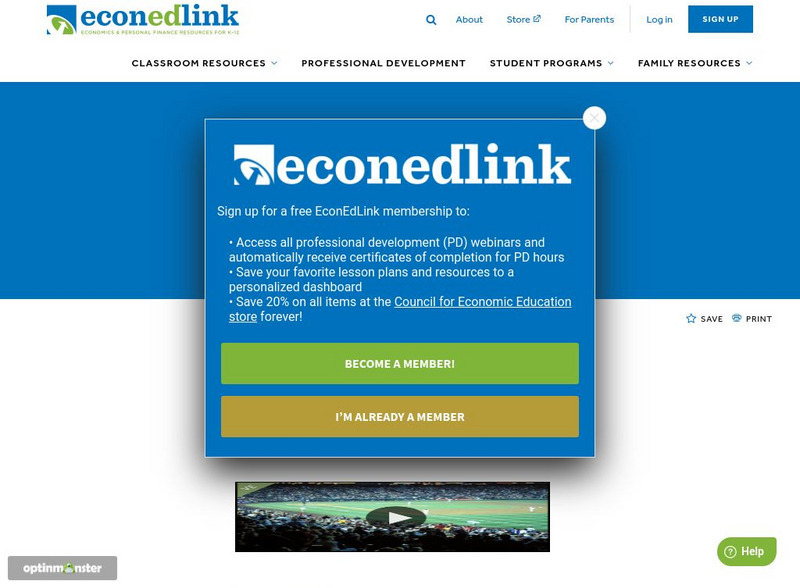Council for Economic Education
Econ Ed Link: Q T Pi Fashions Learning About Credit Card Use
Credit cards are convenient, user-friendly, and at times dangerous. In this lesson, young scholars learn the joys and dangers of using credit as they help Credit, the main character in this activity, solve her credit problems.
Council for Economic Education
Econ Ed Link: u.s. Senate Mulls Over Bankruptcy Legislation
During the week of September 20, 1998, the US Senate agreed to debate a bill (S 1301), intended to make it more difficult for people of means to use bankruptcy to walk away from debt. Those who could pay at least 20 percent of their...
Council for Economic Education
Econ Ed Link: Incentives Influence Us
Find out more about the concept of incentives in our economy through this lesson plan. "You will identify incentives used at home and school."
Council for Economic Education
Econ Ed Link: China Where Will They Fit in the World Economy?
With its emerging middle class, its new markets, and a new emphasis on increasing its technology base, where is China going to fit in the world economy?
CK-12 Foundation
Ck 12: Earth Science: Flow of Energy in Ecosystems
[Free Registration/Login may be required to access all resource tools.] Describes how energy is transfered from one organism to another.
CK-12 Foundation
Ck 12: Fifth Grade Science: Life Science: The Flow of Energy in an Ecosystem
A module that explains what an ecosystem is and how energy and matter move through them. Students will look at the different roles of plants and animals and at ecological relationships in food chains and food webs.
Council for Economic Education
Econ Ed Link: How E Commerce Influences Consumer Choice
In this lesson students learn decision making skills that will help them become better consumers. As consumers they have a variety of alternatives from which to choose. They learn about the importance of price information in making their...
SMART Technologies
Smart: Energy Flow in an Ecosystem
Students learn about Abiotic and Biotic Factors and how they affect the ecosystem in which an animal might live in.
Council for Economic Education
Econ Ed Link: The Credit Card Mystery
Credit Cards are a risky business these days, especially for students and those holding multiple cards. Interest rates on credit card balances have always been high relative to other rates, for several reasons. Despite this, there is...
Council for Economic Education
Econ Ed Link: What Does the Nation Consume?
This lesson will focus on what the nation consumes and how that is measured by Gross Domestic Product (GDP). In the United States, the goods and services produced for household consumption account for about two-thirds of total output.
Council for Economic Education
Econ Ed Link: Income Distribution
This video teaches the concept of Income Distribution. Income distribution refers to how the total income earned ends up divided over members of the economy. The website contains an interactive quiz and links for related lesson plans.
Council for Economic Education
Econ Ed Link: National Parks: Only You Can Prevent the Coming Crisis
What do you think of when you think of the National Parks System? Do you think of the majesty of the Grand Canyon and the redwoods of Northern California? Or does the serenity of Cape Cod and the Everglades come to mind?
Science and Mathematics Initiative for Learning Enhancement (SMILE)
Smile: Teeth Identification in Omnivores, Herbivores and Carniv
For this lesson plan, students make puppets out of paper bags and use corn to give their animal (dinosaur, raccoon, etc.) the correct type of teeth based on the animal's diet.
Channel 4 Learning
4 Learning: Science Essentials: Interdependence and Adaptation
Article describes the importance of green plants and the ideal conditions they need to produce the food and oxygen people need to live.
Tom Richey
Slide Share: Ecosystems and You
Slideshow that looks at energy flow in an ecosystem. Explains what an ecosystem is, how energy flows through it, the producers and consumers of energy, and food chains. Links to a video about plastic debris in the ocean.
Channel 4 Learning
Channel 4 Learning: Science Essentials: Habitats
Find answers to your questions about habitats, producers, consumers, and food chains. Glossary, image bank, suggested activities, and quiz included.
Sophia Learning
Sophia: Living Organisms and Their Environment: Lesson 2
This lesson will discuss the interactions of and interdependence among living things. It is 2 of 4 in the series titled "Living Organisms and Their Environment."
Sophia Learning
Sophia: Living Organisms and Their Environment: Lesson 3
This lesson will discuss the interactions of and interdependence among living things. It is 3 of 4 in the series titled "Living Organisms and Their Environment."
Shmoop University
Shmoop: Ecosystem Energy Flow
Explains the processes by which energy flows through an ecosystem. Covers the meanings of key vocabulary, e.g., types of producers and consumers, trophic levels, food webs, and the energy pyramid.
ClassFlow
Class Flow: Food Chains
[Free Registration/Login Required] Through this flipchart students will be able to summarize and organize simple food chains.
Other
Food Chains and Webs
A very informative site that discusses food chains and webs in detail. Not too complicated and fairly easy to understand, it also includes some pictures.
University of Nebraska Omaha
Ec Ed Web: If You Give a Mouse a Cookie
This lesson plan is cross-curricular, economics and literature. Using the book "If You Give a Mouse a Cookie," students will understand cause and effect and unlimited want, goods and services.
PBS
Nh Pbs: Nature Works: Producers and Consumers
This concise site that provides an explanation of what producers are along with a short quiz to test your knowledge of producers and consumers.
SMART Technologies
Smart: Ecosystem Food Chain and Food Web
Starts with living and non living and works through producers, consumers, food chains and food webs.














